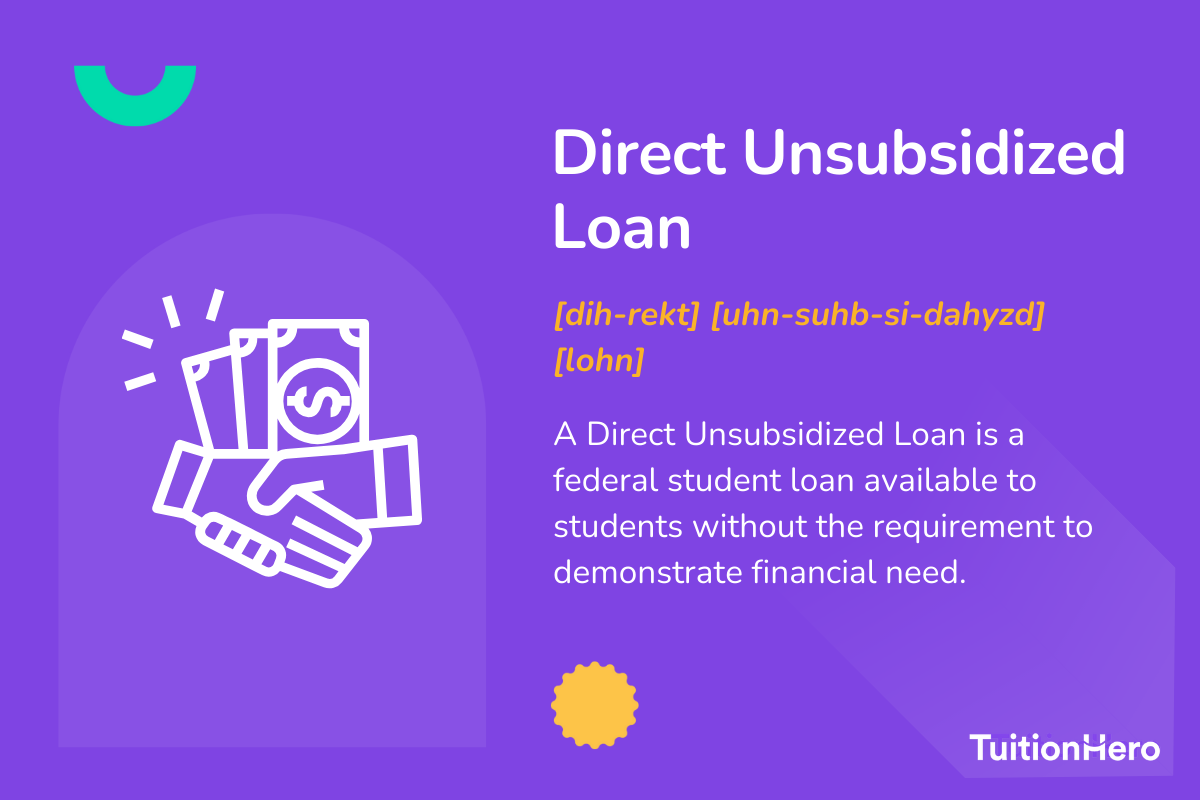Advertiser Disclosure
Last update: November 17, 2024
6 minutes read
What Is a Direct Unsubsidized Loan?
Need to fund your college education? Learn the ins and outs of direct unsubsidized loans, repayment plans, eligibility, and more!

By Brian Flaherty, B.A. Economics
Edited by Rachel Lauren, B.A. in Business and Political Economy
Learn more about our editorial standards



By Brian Flaherty, B.A. Economics
Edited by Rachel Lauren, B.A. in Business and Political Economy
Learn more about our editorial standards
In college finance, it's important to know about subsidized and unsubsidized student loans. This helps you make smart choices when figuring out how to pay for higher education. Just like when you're deciding how to manage your student loans, picking the right federal loan is crucial; it can save you a lot of money in the end. In this post, we'll talk about what a direct unsubsidized loan is and give you other important information you should know.

Key takeaways
- Understand the difference between subsidized and unsubsidized loans
- Interest accrues on unsubsidized loans from the time they are disbursed
- Make informed decisions to manage and minimize your loan burden effectively
What is a direct unsubsidized loan?
A direct unsubsidized loan is a federal loan for college or career school. Unlike subsidized loans, your eligibility for an unsubsidized loan isn't based on financial need.
As a result, interest begins accumulating on the loan amount as soon as it's disbursed - which means your loan balance will grow while you’re still in school, unless you start making payments. However, payments aren't required until after you graduate, typically with a 6 month grace period.

Here are key points to understand about direct unsubsidized loans:
- Interest accrues from the time the loan is disbursed.
- Borrowers are responsible for all interest that accrues, including while in school and during grace or deferment periods.
- Both undergraduate and graduate students may qualify.
Unsubsidized loans are different from subsidized loans (where interest doesn’t accrue while you’re studying) because they’re available to more students, and don’t require that you demonstrate need. Managing how and when you tackle the interest payments can affect the overall cost of your loan.

TuitionHero Tip
For more insights on managing your loans, TuitionHero offers expert advice on finding the right student loans for your education.
Loan limits and eligibility criteria
Let's take a closer look at direct unsubsidized loans. We need to check the loan limits and eligibility criteria. Knowing these things can help you better plan for the financial aspect of your (or your child's) education.
Undergraduate and graduate loan limits
For undergraduate students, the loan limits start at $5,500 annually for first-year students, with a cap of $3,500 for subsidized loans. This limit increases with each academic year, reaching up to $9,500 for independent students or dependent students whose parents are ineligible for Direct PLUS Loans.
Dependent students can borrow up to $31,000 in loans in aggregate, while independent students can borrow up to $57,500. Graduate students have a higher limit of $138,500, which covers both undergraduate and graduate loans. Interestingly, only $65,500 of this graduate amount may be in subsidized loans, a policy adjustment taking place since 2012.
Who qualifies?
Eligibility criteria are pretty straightforward. Applicants must be U.S. citizens or eligible non-citizens with a valid Social Security number, enrolled at least half-time in a program participating in the Federal Direct Loan Program.
They need a high school diploma or equivalent, satisfactory academic progress, and no defaults on existing federal loans. Notably, direct subsidized loans have an extra requirement of demonstrated financial need, which is absent for unsubsidized loans.
Repayment plans and considerations
Understanding the repayment structure is as crucial as knowing how much you can borrow. The Federal Government offers multiple repayment plans catering to different financial situations.
Standard and graduated repayment plans
The Standard Repayment Plan lets you pay back your loan in 10 years with the same monthly amount. On the other hand, the Graduated Repayment Plan starts with smaller payments that go up over time.
This is meant to match how much you earn and progress in your career. Both plans help you repay your loan, but you need to think about your future financial situation before choosing.
Compare private student loans now
TuitionHero simplifies your student loan decision, with multiple top loans side-by-side.
Compare Rates
Income-driven repayment (IDR) plans
In an effort to make student loans more manageable, the government offers several IDR plans, which allows you to pay a percentage of your income - the less you earn, the less you pay. One noteworthy plan, the Saving on a Valuable Education (SAVE) Plan, will soon reduce undergraduate loan repayments to 5% of discretionary income, significantly lowering monthly payments for qualifying borrowers.
The 5% limit will start in July 2024, cutting monthly payments in half from 10% of discretionary income. Not only that, but the remaining balance on these loans is typically forgiven after 20 years of payments.
These choices give you different ways to handle your money when you borrow, based on your financial situation. However, be careful because they might mean you end up paying more interest overall, since repayment timelines tend to be longer.
It's important to make smart decisions - looking for scholarships can help you avoid borrowing too much money for school, making your post-graduate life easier.
To give a clearer picture of how loan limits, interest rates, and repayment options come together, below is a data table summarizing some key facts about federal direct unsubsidized loans.
Direct unsubsidized loan summary
This table shows important details about loans that don't have extra help to make it easier to understand.
Student Type | Annual Loan Limit | Aggregate Loan Limit | Interest Responsibility | Interest Rate (2023-2024) |
|---|---|---|---|---|
Undergraduate (Dependent) | Up to $5,500 | $31,000 | Borrower | 5.50% |
Undergraduate (Independent) | Up to $9,500 | $57,500 | Borrower | 5.50% |
Graduate | Up to $20,500 | $138,500 | Borrower | 7.05% |
Note: If a student qualifies, a portion of these limits may be in subsidized loans.
Dos and don'ts of managing direct unsubsidized loans
Understanding direct unsubsidized loans can be tricky, but it's important to have a clear plan to get the most out of them. Here are some important things to do and avoid to handle these loans well.
Do
Do file your FAFSA early to understand your loan options.
Do explore scholarships and other financial aid to reduce borrowing.
Do consider part-time work or work-study programs so you can make payments while in school
Do choose the right repayment plan for your financial situation.
Do make use of a loan repayment calculator to plan ahead.
Don't
Don't skip interest payments while in school if you can afford them.
Don't borrow more than you need for your education.
Don't ignore loan servicer communications, especially about repayment.
Don't assume all advice is correct. Always research or consult experts.
Don't forget to check if you qualify for loan forgiveness programs.

Advantages and disadvantages of direct unsubsidized loans
Unsubsidized loans help pay for your education costs when other sources of money aren’t enough. They’re important for many students, but they have both pros and cons, like any loan.
- Independence from financial need allows more students to qualify.
- Available to both undergraduate and graduate students.
- Fixed interest rates offer predictability.
- Flexible repayment plans, including income-driven repayment options.
- Interest accrues from disbursement, increasing the total repayment amount.
- Potential for accumulating significant debt if not managed wisely.
- Lack of subsidized interest can make these loans more costly over time.

Why trust TuitionHero
At TuitionHero, we know college costs can be tough. That's why we offer simple financial help. Whether it's loans, refinancing, or scholarships, we connect you to what you need. Our platform explains loan details so you can make smart choices. We'll guide you with easy tools and educational content.
Frequently asked questions (FAQ)
To calculate the interest that accrues monthly on an unsubsidized loan, first find your daily interest rate by dividing your total annual interest rate by 365. Then, calculate the amount of interest that your loan accrues per day by multiplying your loan amount by the daily interest rate. Finally, multiply this daily interest accumulation by the number of days since your last payment.
Be mindful of your interest to manage your loan effectively. For tools and resources to help you understand loan interest better, check out TuitionHero’s guidance on student loans.
Yes, you can switch from a Standard Repayment Plan to an Income-Driven Repayment (IDR) Plan at any time during your loan term. This flexibility allows borrowers to adjust their repayment schedule based on changes in income or other financial circumstances.
It’s important to contact your loan servicer and discuss your options, ensuring you understand any potential effect on your loan's interest and total repayment amount.
The interest rate for federal unsubsidized loans stays the same throughout the loan's life. It's set every year depending on how the financial market is doing.
This fixed rate helps borrowers because they don't have to worry about the rate changing. Keep in mind, while the rates might change yearly for new loans, once your loan disburses, your rate remains the same throughout your repayment period.
When you delay repaying a loan, you have to pay the interest on an unsubsidized loan. Subsidized loans are different; the government takes care of the interest when you postpone payments. But with unsubsidized loans, the interest adds up, and you're on the hook for paying it.
Certain types of loans can be forgiven if you meet certain conditions. For example, Public Service Loan Forgiveness (PSLF) or specific income-driven repayment plans may allow forgiveness after making qualifying payments for several years.
It's important to know the rules of these programs because they can help lower your long-term loan amount if you qualify. Explore your options and eligibility for loan forgiveness with TuitionHero's resources on refinancing and loan forgiveness.
Final thoughts
When dealing with direct unsubsidized loans, it's important to make smart choices. With the correct information, students and parents can easily handle the details of borrowing for education.
The important things to understand are the loan limits, how interest adds up, your repayment choices, and the criteria for eligibility. This knowledge helps you make smart financial decisions that match your long-term education and money goals. By weighing the pros and cons of unsubsidized loans, you can use them wisely to invest in your future education without the unneeded stress.
Source
Author

Brian Flaherty
Brian is a graduate of the University of Virginia where he earned a B.A. in Economics. After graduation, Brian spent four years working at a wealth management firm advising high-net-worth investors and institutions. During his time there, he passed the rigorous Series 65 exam and rose to a high-level strategy position.
Editor

Rachel Lauren
Rachel Lauren is the co-founder and COO of Debbie, a tech startup that offers an app to help people pay off their credit card debt for good through rewards and behavioral psychology. She was previously a venture capital investor at BDMI, as well as an equity research analyst at Credit Suisse.
At TuitionHero, we're not just passionate about our work - we take immense pride in it. Our dedicated team of writers diligently follows strict editorial standards, ensuring that every piece of content we publish is accurate, current, and highly valuable. We don't just strive for quality; we aim for excellence.
Related posts
While you're at it, here are some other college finance-related blog posts you might be interested in.
Shop and compare student financing options - 100% free!

Always free, always fast
TuitionHero is 100% free to use. Here, you can instantly view and compare multiple top lenders side-by-side.

Won’t affect credit score
Don’t worry – checking your rates with TuitionHero never impacts your credit score!

Safe and secure
We take your information's security seriously. We apply industry best practices to ensure your data is safe.
Finished scrolling? Start saving & find your private student loan rate today





